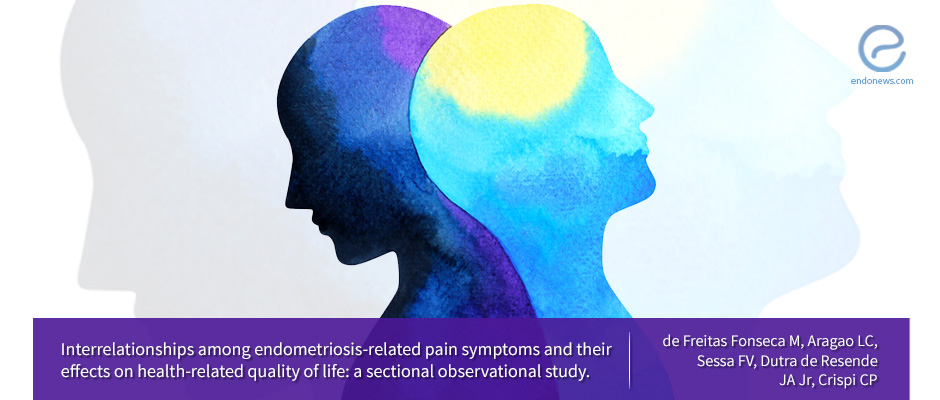Endometriosis, Pain and Quality of Life
Oct 12, 2018
Dysmenorrhea and chronic pelvic pain have the most impact on health-related quality of life in women with endometriosis
Key Points
Highlights:
- This is the first study to assess the correlation between different pain symptoms and different domains of women's health-related quality of life (HRQoL).
Importance:
- To shed light on the actual impact of pelvic pain on women’s mental health and HRQoL would guide the decision-making and may improve treatment.
What's done here:
- Preoperatively enrolled 77 consecutive Brazilian women with deep infiltrating endometriosis (DIE) participated in the study.
- The intensities of dysmenorrhea, deep dyspareunia, chronic pelvic pain, and menstrual and non-menstrual dyschezia were quantified; score "0" represented no pain, whereas "10" represented the worst pain ever felt.
- Concerning HRQoL, the full validated Brazilian versions of two self-reported HRQoL questionnaires were applied (SF36-more general and EHP30 focusing on endometriosis-related complaints).
- Statistical analysis was conducted to review the results.
Key results:
- Dysmenorrhea demonstrated the most independent behavior.
- Chronic pelvic pain and dyspareunia were the most similar in intensity.
- Dysmenorrhea and chronic pelvic pain were the main symptoms correlated with both questionnaires, hence were identified as the most important pain symptoms affecting HRQoL.
Limitations:
- The method of data collection, which is the self-rating of scores.
- The possibility of some selection bias due to the characteristics of the sample, which includes specific racial aspects (75% white), the prevalence of smoking habit (<16%), level of education(75% college graduates), and level of information about the disease (access to a specialized health unit with a multidisciplinary team of surgeons).
Lay Summary
Although studies show that pain in endometriosis is associated with decreased health-related quality of life (HRQoL), details as to which pain symptoms contribute to such a decline have not been explored. For the first time in this study, researchers from Rio de Janeiro, Brazil, explored the correlation between different pain symptoms and different domains of women's health-related quality of life (HRQoL) in their recently published paper published in Obstetrics & Gynecology Science.
The results demonstrated that dysmenorrhea and chronic pelvic pain were the main symptoms correlated with all domains of both questionnaires which analyzed HRQoL, and thus were identified as the most important pain symptoms affecting women’s HRQoL. When different endometriosis-related pain symptoms were compared to each other, dysmenorrhea had the lowest similarity and so had the most independent behavior. On the other hand, chronic pelvic pain and dyspareunia were the most similar in intensity.
Despite the fact that previous studies have reported that dyspareunia is a significant negative predictor of negative sexual function, the study showed that dyspareunia was only one of many determinants of sexual function and a less important symptom in women with endometriosis.
The authors report that this study can assist physicians in discussing “the possible interactions among the main endometriosis-associated symptoms and the differences in their impacts on HRQoL” and thus guide treatment decision-making. They further state that “investigators have emphasized that the medical treatment of endometriosis with pain may be insufficient and psychological intervention may be required since depressive symptoms were independent and significant negative predictors of quality of life in patients with endometriosis.” In addition, they suggest ”improving global sexual function, not just reducing pain during intercourse, should be considered a major clinical goal of endometriosis treatment” and advise more research to be conducted in this field.
Research Source: https://www.ncbi.nlm.nih.gov/pubmed/30254997
Dysmenorrhea Dyspareunia Dyschezia Pelvic pain Womens health

